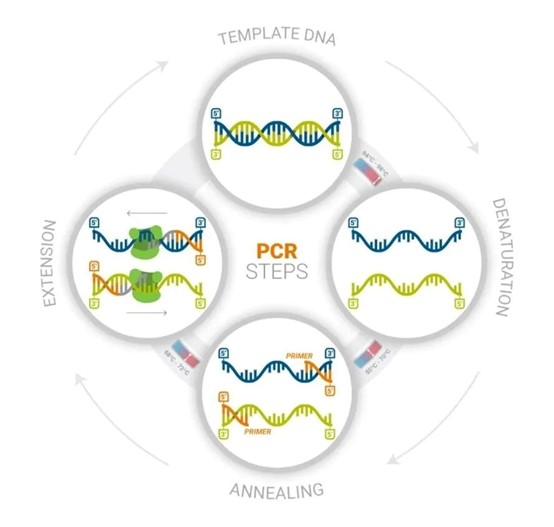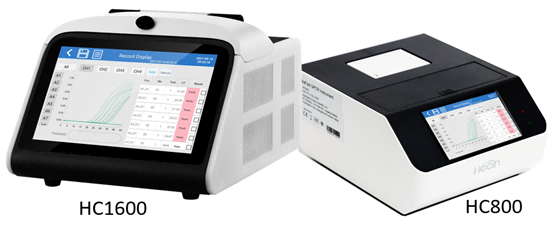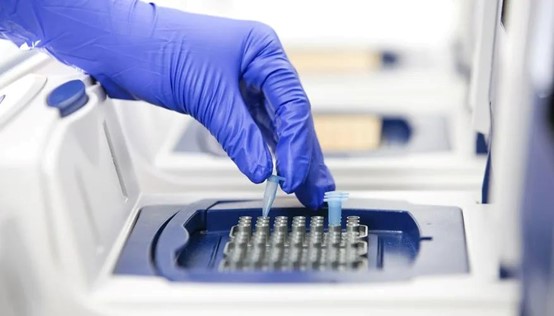A PCR instrument is an experimental apparatus used for performing Polymerase Chain Reaction (PCR). PCR is a widely used technique in molecular biology and genetics research, employed to amplify specific DNA segments. The PCR instrument achieves different steps of the PCR reaction by sequentially changing temperatures, including denaturation, annealing, and extension.

PCR instruments typically have the following characteristics and functions:
1. Uniform temperature control: PCR instruments can accurately control temperature to perform the different steps required for PCR reactions, such as denaturation, annealing, and extension. Temperature can be programmed according to experimental requirements.
2. High-precision temperature detection: PCR instruments are usually equipped with high-precision temperature sensors to ensure the accuracy and stability of reaction temperatures.
3. Well-designed thermal conduction system: PCR instruments typically employ efficient thermal conduction systems to ensure rapid and uniform temperature changes.
4. Automated control and monitoring: PCR instruments are equipped with automated control and monitoring systems, which can automatically adjust temperature changes, display the progress of reactions, and record experimental data.
5. Diverse capacity and sample compatibility: PCR instruments can typically accommodate tubes and sample volumes of different specifications to meet various experimental needs.
6. Connectivity to computers: PCR instruments usually can connect to computers via USB or other interfaces for easy handling and analysis of experimental data.
In summary, PCR instruments are specialized devices for PCR reactions, featuring temperature control, precise temperature measurement, automated control and monitoring, among other characteristics, enabling efficient PCR experiments.

Development History
The development of PCR instruments can be traced back to 1983 when American biochemist Kary Mullis first proposed the method of Polymerase Chain Reaction (PCR). Subsequently, PCR technology gained widespread application in the field of molecular biology, driving the development and improvement of PCR instruments.
1. Initial PCR instruments were built upon early equipment such as constant-temperature water baths and temperature controllers. As demand for PCR technology increased, these early PCR instruments became insufficient to meet experimental needs, leading to the emergence of more advanced PCR instruments. In the 1990s, a trend towards commercialization and marketization of PCR instruments began, with many biotechnology companies producing and selling PCR instruments. These PCR instruments underwent improvements and innovations in temperature control, stability, automation, and multiplexing. Over time, trends in the development of PCR instruments mainly include:
- Improved temperature control and stability: PCR instruments continuously improved temperature control systems to make temperature changes more precise and stable, ensuring the accuracy of PCR reactions.
- Automation and high throughput: PCR instruments began to incorporate automation technologies, including automated reaction setup, sample loading, and experiment execution. This enabled faster and more efficient PCR reactions, capable of processing multiple samples simultaneously.
- Miniaturization and portability: To meet the flexibility and convenience of experiments, some PCR instruments started to develop towards miniaturization and portability, such as portable PCR instruments and micro PCR instruments.
- Further integration of other functions: Some modern PCR instruments have integrated other functions such as fluorescence detection, real-time monitoring, and automated data analysis.
With the continuous advancement of technology and increasing demand, PCR instruments have been continuously improved and innovated in temperature control, automation, sample handling capacity, and real-time monitoring, making PCR technology more convenient, efficient, and reliable.
Principles of operation

1. The working principle of a PCR instrument involves different steps of the PCR reaction, including denaturation, annealing, and extension. Denaturation: At the beginning of the PCR reaction, the PCR instrument heats the reaction mixture to a high temperature (usually 94-98°C) to separate the DNA double strands into two single strands. This step disrupts the hydrogen bonds of DNA, causing the DNA to unwind and making the sequence of DNA fragments available for amplification.
2. Annealing: Subsequently, the PCR instrument lowers the temperature to a lower annealing temperature (usually 50-65°C) to allow primers (or primer pairs) to bind to the target region of the DNA template. Primers are short DNA fragments with complementary base sequences, matching the start and end positions of the target DNA fragment.
3. Extension: Then, the PCR instrument raises the temperature to the optimal temperature for DNA polymerase activity (usually 72°C). At this temperature, DNA polymerase enzyme adds new nucleotides to extend the primers, synthesizing new DNA strands. This step is repeated at each primer binding site, resulting in an exponential increase in the number of DNA strands produced.
4. PCR instruments typically possess the following features and functions to carry out these steps: Temperature control system: PCR instruments utilize high-precision temperature control systems to accurately regulate temperature changes during each step of the reaction.
5. Heating and cooling system: The heating furnace and cooling device used in PCR instruments are essential components for achieving temperature changes in the reaction mixture.
6. Mixing and separation system: PCR instruments are usually equipped with devices for mixing and separating reaction mixtures to ensure uniform reaction.
7. Automation control and monitoring: Many modern PCR instruments feature automated control and monitoring systems that can automatically adjust temperature changes and monitor the progress of the reaction.
8. Data collection and analysis: PCR instruments typically display and collect reaction results in digital form, providing data on the quantity and characteristics of amplification products.
In summary, PCR instruments carry out PCR reactions by precisely controlling temperature and cycling through different steps, resulting in the amplification of DNA fragments. These PCR instruments usually feature temperature control, automation control and monitoring, and data collection and analysis capabilities.
Component parts
PCR instruments consist of multiple components, including temperature control devices, reaction tube loading systems, heating and cooling systems, mixing and separation systems, detection systems, as well as control and data processing systems. Below are common components found in PCR instruments:
1. Temperature control device: One of the core components of a PCR instrument, used for precise control of reaction temperature. Common temperature control devices include Peltier thermoelectric devices and constant-temperature water baths.
2. Reaction tube loading system: The reaction tube loading system of a PCR instrument is used to hold PCR reaction mixtures. It can consist of fixed reaction tube positions or movable reaction tube holders.
3. Heating and cooling system: PCR instruments require systems capable of rapidly heating and cooling to meet the temperature change requirements during PCR reactions. Peltier thermoelectric devices are commonly used to achieve efficient heating and cooling.
4. Mixing and separation system: PCR reactions require thorough mixing of reaction components while also requiring separation of reaction components. Some PCR instruments are equipped with mixing and separation devices, such as shakers, and electric stirrers.
5. Detection system: The detection system of a PCR instrument is used to monitor the progress and results of PCR reactions. Common detection systems include fluorescence detectors, UV-visible spectrophotometers, used to detect PCR products or markers.
6. Control and data processing system: PCR instruments typically come equipped with control panels and displays for setting PCR reaction parameters, monitoring reaction progress, and providing real-time data and results. Some PCR instruments can also be connected to computers for more complex control and data processing.
7. Safety system: PCR instruments are also equipped with safety measures, such as temperature and time limits, overheat protection, to ensure the safe conduct of experiments.
The above components may vary depending on the specific model and functionality of the PCR instrument, but together they facilitate the various stages of PCR reactions, enabling PCR experiments to be conducted conveniently and efficiently.
Classification or type
PCR instruments can be classified based on their functions and design characteristics. Common classifications of PCR instruments include:
1. Conventional PCR instruments: These instruments have basic PCR reaction capabilities and are used for standard PCR reactions, such as amplifying DNA fragments.
2. Real-time PCR instruments: These instruments can monitor DNA amplification in real-time during the PCR reaction, providing amplification curves and quantifying the amount of amplification products.

3. Quantitative PCR (qPCR) instruments: These instruments can quantitatively determine the quantity of target genes in PCR products, used for precise measurement of relative expression levels of RNA or DNA.
4. Digital PCR instruments: Utilizing digital PCR technology, these instruments can directly count the number of molecules in PCR reaction products without the need for standard curve calibration, used for accurate determination of DNA or RNA copy numbers.
5. Thermal cycling PCR instruments: These instruments achieve PCR reactions through thermal cycling, i.e., switching reaction conditions within the same instrument through temperature changes, suitable for complex PCR reaction designs.
6. Multipurpose PCR instruments: These instruments have multiple PCR reaction modes and functions, suitable for different types of PCR reactions such as conventional PCR, real-time PCR, quantitative PCR, etc.
7. Portable PCR instruments: These are small, portable PCR instruments suitable for outdoor or specific location use, equipped with basic PCR reaction capabilities.
Please note that the above classifications are not strictly exclusive, as some PCR instruments may have multiple functionalities and characteristics. Additionally, there are also some specialized types of PCR instruments such as fluorescence quantitative PCR instruments, digital fluorescence PCR instruments, etc.
Fields of application
PCR instruments are laboratory instruments used for Polymerase Chain Reaction (PCR), widely applied in biomedical research, life sciences, and molecular biology fields. Here are the main application areas of PCR instruments:
1. Molecular diagnostics: PCR instruments are extensively used in medical diagnostics, such as detecting pathogens, genetic mutations, and gene expression.
2. Genetic research: PCR instruments are used for genetic experiments including genome analysis, DNA sequencing, gene mutation detection, and gene expression studies.
3. Forensics: PCR instruments are utilized in DNA identification and criminal investigations, such as DNA analysis of crime scene samples.
4. Biodiversity research: PCR instruments are employed to identify, quantify, and analyze DNA or RNA from different biological populations, species, or organisms.
5. Botanical research: PCR instruments are used for plant genome analysis, gene expression studies, transgenic detection, etc.
6. Virology research: PCR instruments are used for detecting, identifying, and quantifying viral infections, such as detecting novel coronavirus.
7. Environmental science: PCR instruments are used for microbial ecology studies, water quality testing, environmental monitoring, etc.
Overall, PCR instruments find widespread applications in molecular biology, aiding scientists in gene analysis, pathogen detection, molecular diagnostics, and more.






